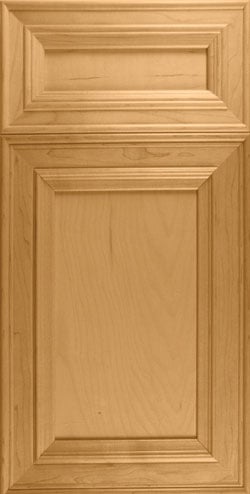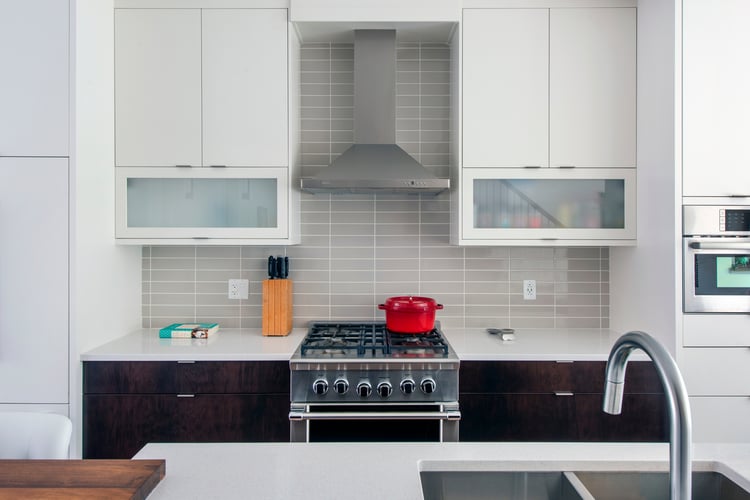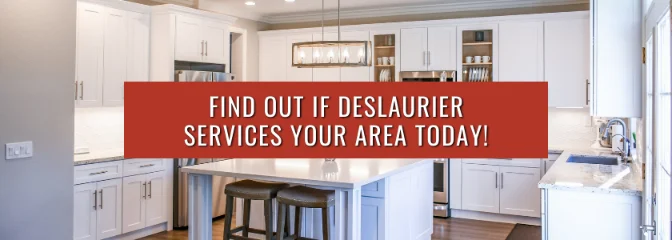9/06/2023 • Blog, Best in Class, Design Tips
Low Maintenance Kitchen Cabinets
Estimated Read Time: 6 Minutes
Whether you’re in the midst of a new build or a kitchen renovation, every homeowner looks for the same qualities in their kitchen: to look good, fit in their budget, and be easy to maintain.
Some things transcend kitchen design sensibilities. You can have a taste for the traditional or an eye for modern style, but every homeowner loves low-maintenance, easy-to-clean kitchen designs.
What better place to start than with the kitchen cabinets?
At Deslaurier, we have over 40 years of experience providing our clients with custom cabinets and kitchen design services. During the design process, our clients often voice their questions and concerns about the potential time and effort involved in maintaining their new custom cabinets.
With the help of our Deslaurier Designer, Amelia Mathieson, we’ll detail several factors that influence how easy (or difficult) your kitchen cabinet design will be to maintain.
Let’s get started!
|
Table of Contents |
Maintaining Kitchen Cabinets
There’s no simple answer when talking about low-maintenance kitchen cabinets.
Plenty of factors like durability, material, and door style are at play when determining how much maintenance your kitchen cabinets will require.
Is the material durable and smooth, making it resistant to damage and also easy to clean?
Is a simple microfiber cloth sufficient, or are specific cleaning products necessary?
Does the door style have detailed millwork that can trap dust and grime?
Or is the cabinet finish able to hide slight damage and easy to repair?
These (and many more) are important questions and concerns to ask when picking out your cabinetry. Let’s take a look at them.
Door Styles
The door style you choose can play a big part in your routine cabinet upkeep.
There are generally two types of door style classification: 5-piece or 1-piece.
As you might have guessed, 5-piece cabinet doors are constructed using 5 individual segments. A 5-piece cabinet door consists of one centre panel, while two "stiles" (running vertically) and two "rails" (running horizontally) form the frame of the door.


Within that, they can also have different designs including raised panels, arched-top, and any number of applied mouldings (like in the doors above) for some added details.
All of these can add crevices and obstacles that collect dust, dirt and grime.
“That’s the thing I hear most about five-piece doors, people worry about the ledges or seams at the bottom.” - Amelia Mathieson
The simpler the door style, the easier it is to clean.
Speaking of simple, a slab (flat) door style is all it takes to cut back the time you spend cleaning your kitchen.
The slab cabinet door style is designed with a simple, minimalistic flat surface, catering to homeowners who value low-maintenance features.
In terms of actual upkeep and cleaning, the flat slab or 1-piece doors are easiest. It’s the universal go-to choice for an easy-to-clean kitchen, whether you opt for a painted wood cabinet door or an acrylic door.
“Read the cleaning information we give you in our warranty and clean them properly.” - Mathieson
Great advice, which you can learn about in-depth in our article: How to Clean Kitchen Cabinets.
Modern Manmade Materials
These days, there are plenty of different cabinet materials to choose from than just wood or painted MDF.
Man-made, engineered products like thermofoil and acrylic have become commonplace in contemporary kitchen design as alternatives to conventional stained or painted cabinets.
Thermofoil is a vinyl colour coating that is heat-shrunk over a 1-piece cabinet door. Thanks to the 1-piece door, it doesn’t have any seams or crevasses where dust can build up. Even if the door has detail to it, the thermofoil finish will be on top of that surface. Which makes thermofoil cabinets an ultra-easy, wipe-and-go product.
Similarly, acrylic is a robust synthetic coating commonly applied to slab doors, known for its high durability. It features a glossy, reflective surface that may attract fingerprints and smudges, but they can be effortlessly wiped away. With the exceptional durability of the finish, you can effectively prevent scratches for an extended period.
“In terms of durability and cleaning, the modern stuff is all quite similar.” - Mathieson
Acrylic is physically the hardest material - so most likely the hardest to damage as well.
While thermofoil and acrylic both offer great painted aesthetics for creating a low-maintenance kitchen, thermofoil is the more budget-friendly option of the two. Acrylic is typically a premium product that comes at a higher price range.
Lastly, acrylic is applied on the front and edges of the door, so there are seams that aren’t present on thermofoil. In theory, these seams can separate. Although it’s not very common, if they were to lift or break apart it would happen on the edges of the door.
Stains and Paints
If easy maintenance is your priority, stains will fare better for you than paints.
Stained doors withstand more wear and tear than painted doors because the visible wood grain works like camouflage. The wood grain pattern is very forgiving when scratches and dents inevitably happen in the home.
Even if the door is slightly damaged, those minor imperfections can blend into the style, particularly for intentionally worn or distressed cabinet designs.
Plus, the stain is much easier to touch up, too!
All you need is a wood stain marker to mask unsightly damage. Paint touch-ups, on the other hand, are much more noticeable if you don’t have a 100% colour match.
“For general wear and tear, paints and stains are much easier to repair than something like a thermofoil.” - Mathieson
That’s not to say painted cabinets can’t be repaired. If the damage isn’t too bad, you can certainly touch up a painted finish.
For cleaning, it’s all quite similar once the wood has been sanded and prepped for finish.
However, one minuscule thing worth mentioning is that oak may be slightly difficult to clean. Just because of its slightly open and raised grain pattern. You can feel the grain on the texture of the door and that might be slightly different to clean and wipe down.
Other wood species like birch, maple, walnut or cherry have really smooth surfaces thanks to their closed grains.
Cabinet Hardware
In addition to the cabinet materials and finishes, choosing the right hardware can also contribute to low-maintenance cabinets.
When choosing a handle, though, you might want to steer clear of oversized handles with large, flat surfaces. Oversized handles can collect dust and even crumbs when they fall off your countertop.
Further, some handles have a textured surface due to their finish. Sometimes that texture is quite deep, so cleaning it can be difficult compared to a smooth, polished handle.
Simply put, the best easy-to-clean hardware choice is a handle with a simple design. Opt for hardware that is comfortable to grasp and easy to clean.

Smooth, sleek designs without any intricate details tend to accumulate less dirt and grime.
Learn more about how to choose cabinet hardware here!
Additionally, modern-style tab pulls (as pictured above) on base drawers have their own unique issue.
Since tab pulls are installed on the top edge of the door, they sit right below the countertop which can result in them being scratched by the bottom of the surface.
“That’s because instead of pulling the drawer open we have a tendency to “lift” and then the tab pull rubs against the underside of the countertop.” - Mathieson
If you’ve ever felt underneath your countertop overhang, you know the texture is not nearly as smooth or polished as the surface.
Further, the hardware you choose inside your cabinets like door hinges also plays a part in maintenance.
Go with soft-close hinges and drawer slides. Investing in high-quality hinges and slides that prevent slamming not only adds convenience but also reduces wear and tear on the cabinets.
Skip Open Shelving
Lastly, if you're really concerned about continuous maintenance, forgo the route of open shelving.
Whether it’s floating shelves or open cabinetry, these types of storage solutions are a big hit in contemporary kitchen design, offering homeowners a place to keep things like bowls, glassware and even flowers or plants on display.
While open shelving may be a fashionable industry trend, it’s not always an ideal match for a low-maintenance kitchen.
A common issue with open shelving is the accumulation of dust and grime. Dust can collect rapidly onto your shelving, resulting in a need for routine wipe-downs.
Another requirement with open shelving is keeping a tidy, clean space. Especially if you keep décor and unique items on display, you’ll find that open shelves demand a lot of attention in order for a presentable display.
If you’re very organized and diligent with your presentation, using these open-storage methods is great! If you’re not interested in even more places in your kitchen for dust and dirt to collect, you might want to skip the open shelving.
Design with Deslaurier Custom Cabinets
As you can see, there are several factors that come into play in order to find a cabinet design that’s easy to maintain.
Ultimately, crafting a kitchen design will always come down to your lifestyle, style preferences, and budget. Consider these accordingly and you’ll be able to create the perfect kitchen design to fit your home!
If you’re looking to install the perfect custom cabinets in your dream kitchen, Deslaurier has everything you need! With over 40 years of experience in our name, we provide our clients with a fully customized design process with our talented team of designers.
Book a consultation today with a Deslaurier design expert at our Jupiter, Florida Showroom or schedule a virtual meeting!
Live outside the area? Visit our Find a Dealer page to connect with a Deslaurier dealer near you! Interested in becoming an authorized Deslaurier dealer? Visit our Become a Dealer page to learn more!

